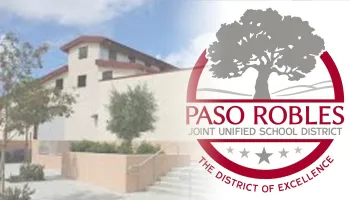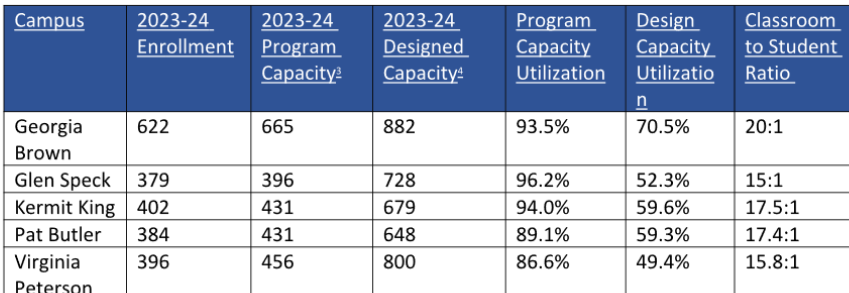Protect students, support Paso Robles Dual Immersion Program
January 20, 2024

OPINION by BRIAN MAXTED
With more than 600 Paso Robles students in the Dual Immersion Program at Georgia Brown Elementary School, the 36th Street campus has grown to become the district’s largest and most sought after elementary school program.
Until recently switching to a lottery system to handle the demand, parents from all over Paso Robles and beyond would camp out overnight to secure their children’s spot in the program that provides the fundamentals of both Spanish and English. Its administration is excellent, Principal Celia Moses was recently awarded Woman of the Year. In recent statewide tests, the district scored 19.3% in EL Student’s Progress, compared to the district wide average of 2.9%.
However, the program’s success can be attributed to more than simply language — it is a reflection of the Paso Robles community where people of diverse racial, socioeconomic, rural and more urban backgrounds choose to send their children on a shared adventure of academic, cultural, language and social exploration and unity. In 2024, Georgia Brown is achieving what many parts of our country sorely lacks — choosing to come together regardless of backgrounds.
The results speak for themselves, the Dual Immersion Program has grown over the years and is now 66% larger than any other district elementary school program and remains oversubscribed, where all other elementary and middle school campuses are substantially under capacity. Specifically, all five of the other public elementary schools in the district have underutilized space, of between 44% to 66% of capacity.


Many of the demographics of the few new families moving into the district consist of either agricultural workers, often from a native Spanish-speaking family, or teleworkers who have fled the chaos of urban areas for the sanity, high quality of life and relative prosperity of Paso Robles.
Ultimately, the district has a generational challenge on its hands — how to manage a declining number of overall school-aged children with existing infrastructure and resources while maximizing the educational experiences for families in the community.
The district’s track record in the recent past of managing these precious and decreasing resources has been so detached from reality and effective governance that in 2020 a San Luis Obispo Grand Jury released a report titled, “Paso Robles School District: A Cautionary Tale.”
The report stated “that the District’s collective failures to control or report on excessive expenditures created a fiscal crises that will take time and hard work to resolve.” According to the report, from 2014 through 2018, the district’s reserves declined from about 10% of the annual budget, or more than $6 million, to approximately 0.4 %.
All the while, the Dual Immersion Program has flourished despite being resource neglected for decades. In talking to some, there used to be a large overcurrent (and perhaps now, more of an unspoken undercurrent in some corners) that only English should be taught in our elementary schools.
At the center of this controversy is the physical campus at 36th Street, originally built in 1948, the campus is beyond its useful life and in a shameful state of disrepair with real questions about health and safety, including mold, pest infestations, leaky roofs, broken heaters and air conditioners, and structural concerns where entire wings consists of unreinforced masonry and aging structural supports that may not hold as well in the next large earthquake.
Not to mention that as part of an exploratory environmental impact report for renovations it was discovered that the entire 36th Street campus sits on a geological anomaly that may make building on the site in the foreseeable future well delayed to potentially unfeasible. Is it coincidence that the school located in one of the lowest income parts of Paso Robles is one of the oldest campuses, the last to be renovated, and kept in a state of disrepair for shamefully long?
In the upcoming weeks, the school board is going to make its fourth plan in five years on where to physically accommodate the Dual Immersion Program. Although the district states that it is dedicated to the success and continuation of the Dual Immersion Program, actions speak louder than words.
Instead of prioritizing its largest and most sought after program that is bringing real choice, diversity, and results to the district, the options currently being discussed most by the board and the district Advisory Committee include:
- keeping the Dual Immersion Program on a crumbling 36th Street campus that is busting at its seams and presents ever growing health and safety concerns;
- dividing the Dual Immersion Program into multiple other elementary school campuses, fracturing its unique community and risking diluting or disintegrating its success;
- shoving 600 plus students into the undersized temporary trailer campus next to Flamson on 24th Street that will be an absolute traffic nightmare and no line of sight on a permanent home or confirmation that funds actually exist to build one.
All three of these solutions severely put at risk the continued success of the program. Is the assumption that because the program is so popular, community parents will just deal with ever growing risks to health and safety?
As a parent in this community engaged with other Georgia Brown parents and teachers alike, I know for a cold hard fact that the above current options being discussed put in real jeopardy one of the crown jewels of the Paso Robles School District.
Each enrolled student in a public elementary school brings about $14,000 per year in state tax money to the district teacher salaries, administrators, infrastructure and ongoing expenses.
The Dual Immersion Program has nearly 70 students from partner districts in the greater unified school district, namely Templeton, San Miguel and Atascadero. This means that the Dual Immersion Program is bringing in nearly a million dollars a year from neighboring districts into the Paso Robles School District.
For an area that is facing declining school-aged demographics, underutilized campuses, and past and potential future budget shortfalls, the Dual Immersion Program is the golden goose that the district has been plucking to feed whatever it is they have been doing at the detriment of its largest, most diverse and most in demand program.
What would happen if the Dual Immersion Program left Paso Robles all together? Hypothetically, the program could move its experience, administrators, teachers and families seven miles up the road to the San Miguel, which with its native speaking Spanish population would well meet the demand and state’s requirements of a 50% native Spanish speaking student body. Imagine 300 students up and leaving for San Miguel – that is more than $4 million in state tax dollars that would leave the Paso Robles School District.
And yet, there are multiple solutions that embraces this highly successful and long neglected community and helps fortify the district during this period of overall decline of school age enrollment and potential upcoming budget shortfalls. These solutions include:
- movement of the Dual Immersion Program to Winifred Pifer or Bauer Speck campuses and redistribute school boundaries of those campuses to other elementary schools or
- consolidation of either middle school campus and placing the Dual Immersion Program in either Flamson or Lewis and perhaps, with a little bit of vision, extending the Dual Immersion Program through 8th grade to both alleviate the pressure on just one middle school campus and lean into the strength that the Dual Immersion Program brings to the district.
What if the district brought 6th grade back to elementary schools and moved the Dual Immersion Program into one of the two middle schools? Sure this would involve change, but plenty of school districts around the country have 6th grade as part of elementary school and such a move would evenly distribute those rising 6th graders throughout the open seats on their existing, non-crumbling, elementary school campuses.
Any of the above choices would be a better use of existing resources and leaves potential capital dollars to either allocate to other worthy programs.
Talk about consolidation of campuses brings understandably emotional reactions from those with school-aged children, residents living in the surrounding area, and the teachers and administrators. However, whether in business or government, leaders are put in place to lead, which often means making hard choices with limited resources and taking into consideration what is in the best interest of all stakeholders.
Emotional sentiments are important, but putting safety and mission first, wisely using resources, building on strengths, and managing and empowering the human capital is paramount to the success of any large organization. Effectively making a change is about shepherding past the perceived hardship of something like a move or consolidation and remembering that these choices are made primarily for the benefit of all the children in our community to attend a safe and healthy learning environment and to empower parents with the educational choices they seek for their children — not necessarily tied to anyone particular name, building, or location.
I have watched the leadership in Paso Robles make hard decisions before regarding business continuity during COVID and whether CRT should or should not be taught in our district. And whether you agree or disagree with their decision in such instances, our leaders listened to all stakeholders and took a position on what they felt was in the best overall interest for our community.
But indecision of a temporary campus is also a decision, and continual neglect of the Dual Immersion Program and the communities it supports is risking one of the district’s best success stories.
Ultimately, the challenge I present to the Paso Robles District School Board is do not simply be reactive to one constituency’s or another’s loudest squeaky wheels but rather take this opportunity to further clarify the district’s mission and vision, take the demographic trends seriously so we can maintain all our hard working teachers and administrators, keep the children and parents who trust them with their children’s education first and foremost in mind, be wise with limited resources (especially given past indiscretions), and use the need for change to drive innovate solutions.
For me, the choice is clear, although the big shiny new building for the Dual Immersion Program at 36th street sounds in theory incredible, I do not believe it is justified at this time given the available room in the district, declining future demographics, and past and future budget challenges. And if we keep dangling this out to stakeholders as if it’s a real or responsible reality, it will also delay the hard and prudent choices.
Unquestionably, allowing students to go to school in the conditions that exists on the 36th Street campus is shameful and a dereliction of basic duty.
The district needs to choose a consolidation path, start planning immediately to be carried out no later than the beginning of next school year or perhaps sooner if the conditions at the 36th Street deteriorate further, and stick to it through the noise carrying hearts and minds along the way. Paso Robles was built on common sense, a community coming together to overcome obstacles, and a dash of maverick boldness — now more than ever we need that spirit driving the solutions for a better Paso Robles School District for generations to come.
The upcoming Paso Robles Unified School District Board meeting where this action will be further discussed, and perhaps decided, is scheduled for Jan. 23 at 6 p.m. at the District Offices at 800 Niblick Road.
Brian Maxted is a Paso Robles resident, parent of two Dual Immersion Program students and CEO of Holloway – a local company.






The comments below represent the opinion of the writer and do not represent the views or policies of CalCoastNews.com. Please address the Policies, events and arguments, not the person. Constructive debate is good; mockery, taunting, and name calling is not. Comment Guidelines